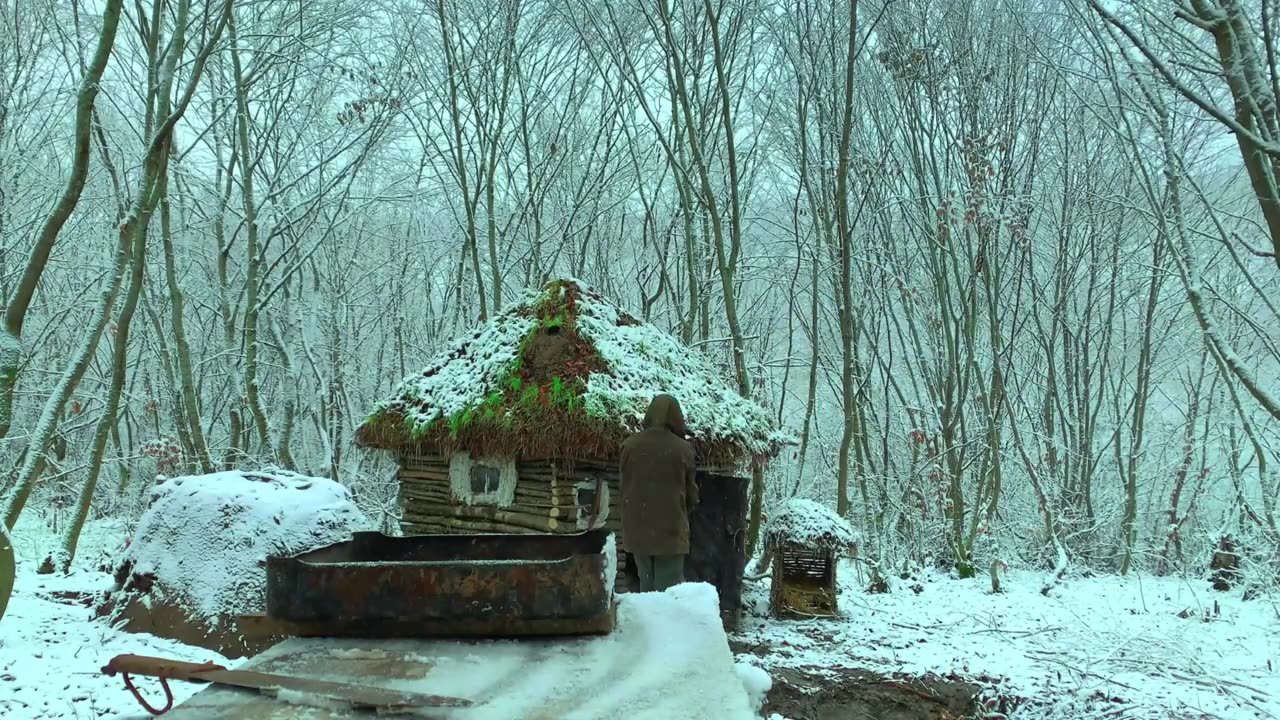Premium Only Content

Building complete and warm survival shelter Bushcraft log cabin, grass roof & fireplace with clay.
Building complete and warm survival shelter. Bushcraft log cabin, grass roof & fireplace with clay
How to Build the Shelter:
Find one long, sturdy branch. It should be a few feet longer than your height.
Prop one end of branch up on a tree stump or log. ...
Lean shorter branches against the branch. ...
Now cover the frame with leaves, branches, or other brush.
What is the best shelter to build in the wild?
Here's a quick look at just a few.
An insulated tree well. Because the branches of an evergreen tree catch snow before it hits the ground, the area around the trunk makes a great place for a simple shelter. ...
An igloo. One of the strongest snow shelters you can build is an igloo. ...
A lean-to.
How do you build a good shelter in the wilderness?
Start by building a rectangular frame from logs. Fill the frame with debris, such as dried leaves or pine branches. The debris will provide insulation that will prevent the ground from drawing heat away from the body. This is extremely important, as most body heat is lost through ground transfer.
How do you make a permanent shelter in the woods?
The basic materials you need are branches for the frame, something to lean the frame upon such as two trees or a wall, and a tarp or coverage to cover your frame. This shelter is perfect even for rainy conditions, windy conditions, or sunny conditions by positioning the shelter against the sun or wind.
What are the 5 C's of bushcraft?
To know which pieces of equipment to take with you in any survival situation, most experts will recommend the 5 C's of Survival: cutting, combustion, cover, containers, and cordage.
What are the 3 types of shelter?
The three shelter categories are: hasty, semi-permanent, and permanent. Shelter is one of the core essentials of survival
How do people survive in the wilderness in the winter?
5 Winter Survival Tips for Outdoor Adventurers [UPDATED FOR 2022]
Making a fire.
Building a shelter for overnight.
Getting (and staying) dry and warm.
Staying hydrated.
Getting enough food.
What is the warmest survival shelter?
Occupied, it was often close to 40 degrees. On our coldest night, at 9 F outside, it was 37 F inside the igloo. The Takeaway: Overall, igloos are the warmest and sturdiest winter backpacking shelters we've tried.
How deep should a survival bunker be?
10 feet
Packed earth insulates against radiation and blast waves, but don't go deeper than 10 feet; if your exits (make two) become blocked in the blast, you may need to dig yourself out.
How long can you survive without shelter in the wild?
You can survive for 3 Hours without shelter in a harsh environment (unless in icy water) You can survive for 3 Days without water (if sheltered from a harsh environment) You can survive for 3 Weeks without food (if you have water and shelter)
What is the easiest shelter to build?
The simplest shelter is a fallen tree that has enough room under it for you to crawl in. Lean branches against the windward side of the tree (so the wind is blowing into it and not against it) to make a wall. Make the wall thick enough to keep out wind.
How did people survive winter hundreds of years ago?
They hibernated, according to fossil experts. Evidence from bones found at one of the world's most important fossil sites suggests that our hominid predecessors may have dealt with extreme cold hundreds of thousands of years ago by sleeping through the winter.
How did people survive the cold in the old days?
When the first humans migrated to northern climates about 45,000 years ago, they devised rudimentary clothing to protect themselves from the cold. They draped themselves with loose-fitting hides that doubled as sleeping bags, baby carriers and hand protection for chiseling stone.
Are humans meant to sleep more in winter?
More sleep is natural in the wintertime, according to the National Sleep Foundation. The normal range is an extra 1.75 to 2.5 hours per night. The key thing is to limit your sleep to between 7-10 hours per night
Do people who live in the cold age slower?
A national vital statistics report shows several reasons why living in colder climates may help you live longer, one is the refrigerator effect, basically cold temperatures do help to slow the aging process while also killing off dangerous insects and bacteria that might otherwise survive in locations closer to the ...
Why can't we sleep through night in the winter?
Adjusting to Winter
When winter arrives, the days are shorter and the nights are longer so there is less sunlight. As a result, our circadian rhythms need to adjust. When the sky is darkening earlier in the evening, the body automatically prepares itself for rest, so we become a little more tired than usual.
-
 15:27
15:27
Sideserf Cake Studio
1 day ago $14.20 earnedThis K-Pop Demon Hunters CAKE is how it's done, done, done!
57.5K15 -
 54:47
54:47
Side Scrollers Podcast
1 day agoSide Scroller Presents KING OF THE KART | MASSIVE MARIO KART TOURNAMENT
92.7K2 -
 LIVE
LIVE
Astral Doge Plays!
4 hours agoZelda NES Randomizer ~LIVE!~ Let the Randomization Begin!
94 watching -
 33:18
33:18
Athlete & Artist Show
14 hours ago $2.81 earnedHockey Is Back In Europe!
37.7K4 -
 LIVE
LIVE
Chi-Town Gamers Livestreams
4 hours ago $0.67 earnedGears 5 Ep. 4 W/ CTG | Into Kait's Mental Issues | GOW: RELOADED LATER & SHENANIGANS 😎
20 watching -
 LIVE
LIVE
Scottish Viking Gaming
7 hours agoSUNDAY FUNDAY :|: Still in the original packaging! Mint!
23 watching -
 2:20:14
2:20:14
LumpyPotatoX2
5 hours agoKOMPETE: Quick Gameplay - #RumbleGaming
15.4K1 -
 9:06
9:06
nospeedlimitgermany
1 day ago $1.71 earnedMercedes-Benz 500 SE W126 | 231 PS | Top Speed Drive German Autobahn No Speed Limit POV
23.1K6 -
 39:33
39:33
Chris Harden
8 days ago $2.54 earnedKansas Backroads | What's Really Out Here? - Rush County
16.3K17 -
 23:49
23:49
marcushouse
1 day ago $1.56 earnedStarship Flight 10 Secrets Revealed & Future of Starbase! 🔥
14.4K7